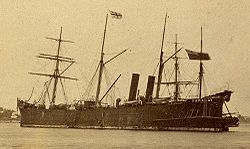Faraday (ship, 1874)
|
The cable layer Faraday
|
||||||||||||||||||
|
||||||||||||||||||
|
||||||||||||||||||
|
||||||||||||||||||
After the Danish company HC Oerstedt, the Faraday steamship was the second cable layer specially designed and built for this purpose . Its conception has long been considered the standard for subsequent cable layers. The Faraday started operations in 1874 for the brothers Wilhelm and Werner Siemens and laid the first permanently functional transatlantic telegraph cable .
history
The Faraday was built in 1873 and 1874 by William Froude at the Charles Mitchell and Company shipyard in Newcastle upon Tyne , based on a design by the Siemens brothers . On February 17, 1874, the ship went into operation. The traditional ship was christened by Wilhelm Siemens' wife, who named it Faraday , a friend of Wilhelm.
Wilhelm began laying a second transatlantic telegraph cable on the Faraday in 1874 (the Great Eastern succeeded the first ). The laying began in Ballinskelligs Bay, Ireland, on the Iveragh Peninsula and led across the Atlantic to Halifax in Canada. Although there were technical problems and the cable that had already been laid broke, the company was ultimately successful and the cable was still functional until 1931.
In 1879 a second transatlantic cable was laid from Brest, France, to Cape Cod in southeast Massachusetts . In 1881, Faraday laid a third telegraph cable, this time from Cornwall to Canso on Canada's Nova Scotia peninsula . A total of five more cables were laid in the North Atlantic.
The Faraday then went to the Caribbean in 1890 . There, Saint Croix was connected to St. Lucia , Saint Lucia to Grenada and Grenada to Trinidad . The following year, the first connection was made from Bacton in the English county of Norfolk to the German island of Borkum . The cable layer then laid over 3,330 kilometers of cable between Chile and Peru in western South America .
After establishing vital communications links for around 50 years, the Faraday was sold for scrapping in 1923. However, the still completely intact hull encouraged a conversion as a coal depot ship. After the engine and boiler had been removed , the ship, now known as Analcoal , was towed to Algiers with 8,500 tons of coal on board . Around 1931 the ship came to Gibraltar and Sierra Leone . After further minor modifications, it then served as a naval supply ship in World War II .
At the end of 1951, the former Faraday arrived at a shipyard in Newport , where it was finally scrapped.
After the ship was sold in 1923, Siemens Bros. & Company from London built a successor that was also named Faraday . But in 1941 this new cable layer was sunk by a German bomb attack.
technology
The 109.88 meter long and 15.93 meter wide cable lay had a draft of 12.1 meters. The size was 5,052 gross register tons .
Two compound machines acted on two propellers, the diameter of the high pressure cylinder being 99.1 cm and that of the low pressure cylinder 172.7 cm. The piston stroke was 121.9 cm. The Faraday had an additional rudder in the bow for the necessary, fine maneuverability during cable laying . The submarine cables were transported in three cable containers, which had a diameter of 13.72 and 11.28 meters and a height of 8.84 meters. With the help of steam-driven pumps, they could be flooded with water. The laying was carried out using cable reels at the bow or stern.
In addition, the Faraday was one of the first ships of its time to have electric light. Outwardly, two chimneys inclined slightly aft were characteristic.
literature
- Vierus, Dieter: Cable layers from all over the world . 1st edition. transpress, Berlin 1989, ISBN 3-344-00394-1 .
Web links
- Deutsche Telekom trade journal, Volume 52, Across the Seas of the World - pp. 629, 630 - file 5.5 MB; last viewed on October 31, 2013
- www.atlantic-cable.com: History of the Atlantic Cable & Undersea Communications, CS Faraday (1) (English); last viewed on October 31, 2013
Individual evidence
- ↑ The Former Cable Ship "Faraday." In: The Shipbuilder and Marine Engine-Builder . Vol. 58, No. 519 . Shipbuilder Press, Newcastle-on-Tyne December 1951, pp. 783 .
